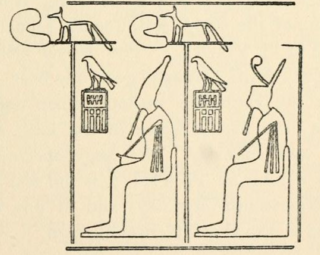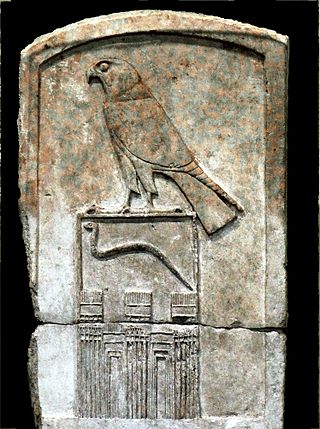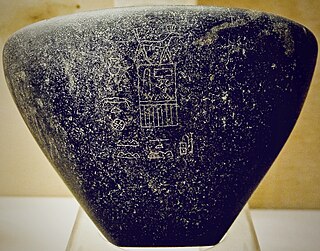
Pharaoh is the vernacular term often used for the monarchs of ancient Egypt, who ruled from the First Dynasty until the annexation of Egypt by the Roman Empire in 30 BC. However, regardless of gender, "king" was the term used most frequently by the ancient Egyptians for their monarchs through the middle of the Eighteenth Dynasty during the New Kingdom. The earliest confirmed instances of "pharaoh" used contemporaneously for a ruler were a letter to Akhenaten or an inscription possibly referring to Thutmose III.

The First Dynasty of ancient Egypt covers the first series of Egyptian kings to rule over a unified Egypt. It immediately follows the unification of Upper and Lower Egypt, possibly by Narmer, and marks the beginning of the Early Dynastic Period, when power was centered at Thinis.

Narmer was an ancient Egyptian pharaoh of the Early Dynastic Period. He was the successor to the Protodynastic king Ka. Many scholars consider him the unifier of Egypt and founder of the First Dynasty, and in turn the first king of a unified Egypt. He also had a prominently noticeable presence in Canaan, compared to his predecessors and successors. A majority of Egyptologists believe that Narmer was the same person as Menes. Neithhotep is thought to be his queen consort or his daughter.

Tetisheri was the matriarch of the Egyptian royal family of the late 17th Dynasty and early 18th Dynasty.

Sobekneferu or Neferusobek was a pharaoh of ancient Egypt and the last ruler of the Twelfth Dynasty of the Middle Kingdom. She ascended to the throne following the death of Amenemhat IV, possibly her brother or husband, though their relationship is unproven. Instead, she asserted legitimacy through her father Amenemhat III. Her reign lasted 3 years, 10 months, and 24 days, according to the Turin King List.

Djer is considered the third pharaoh of the First Dynasty of ancient Egypt in current Egyptology. He lived around the mid 31st century BC and reigned for c. 40 years. A mummified forearm of Djer or his wife was discovered by Egyptologist Flinders Petrie, but was discarded by Émile Brugsch.

Hor-Aha is considered the second pharaoh of the First Dynasty of Egypt by some Egyptologists, while others consider him the first one and corresponding to Menes. He lived around the 31st century BC and is thought to have had a long reign.

Djet, also known as Wadj, Zet, and Uadji, was the fourth pharaoh of the First Dynasty, successor of Djer. Djet's Horus name means "Horus Cobra" or "Serpent of Horus".

Umm El Qaʻāb is a necropolis of the Early Dynastic Period kings at Abydos, Egypt. Its modern name means "Mother of Pots" as the whole area is littered with the broken pot shards of offerings made in earlier times. The cultic ancient name of the area was (w-)pkr or (rꜣ-)pkr "District of the pkr[-tree]" or "Opening of the pkr[-tree]", belonging to tꜣ-dsr "the secluded/cleared land" (necropolis) or crk-hh "Binding of Eternity".

Nitocris I served as the heir to, and then, as the Divine Adoratrice of Amun or God's Wife of Amun for a period of more than seventy years, between 655 BC and 585 BC.

Merneith was a consort and a regent of Ancient Egypt during the First Dynasty. She may have been a ruler of Egypt in her own right, based on several official records. If this was the case and the earlier royal wife Neithhotep never ruled as an independent regent, Merneith may have been the first female pharaoh and the earliest queen regnant in recorded history. Her rule occurred around 2950 BC for an undetermined period. Merneith’s name means "Beloved by Neith" and her stele contains symbols of that ancient Egyptian deity. She may have been Djer's daughter and was probably Djet's senior royal wife. The former meant that she would have been the great-granddaughter of unified Egypt's first pharaoh, Narmer. She was also the mother of Den, her successor.

Seth-Peribsen is the serekh name of an early Egyptian monarch (pharaoh), who ruled during the Second Dynasty of Egypt. His chronological position within this dynasty is unknown and it is disputed who ruled both before and after him. The duration of his reign is also unknown.

Anedjib, more correctly Adjib and also known as Hor-Anedjib, Hor-Adjib and Enezib, is the Horus name of an early Egyptian king who ruled during the 1st Dynasty. The Egyptian historian Manetho named him "Miebîdós" and credited him with a reign of 26 years, whilst the Royal Canon of Turin credited him with an implausible reign of 74 years. Egyptologists and historians now consider both records to be exaggerations and generally credit Adjib with a reign of 8–10 years.

Neithhotep or Neith-hotep was an ancient Egyptian queen consort who lived and ruled during the early First Dynasty. She was once thought to be a male ruler: her outstandingly large mastaba and the royal serekh surrounding her name on several seal impressions previously led Egyptologists and historians to the erroneous belief that she might have been an unknown king. As the understanding of early Egyptian writings developed, scholars learned that Neithhotep was in fact a woman of extraordinary rank. She was subsequently considered to be the wife of unified Egypt's first pharaoh, Narmer, and the mother of Hor-Aha.
Seshemetka was an ancient Egyptian queen from the First Dynasty of Egypt, a wife of pharaoh Den and the mother of Anedjib. Her royal titles were Great one of the hetes-sceptre , She who sees Horus , She who carries Seth .

Benerib was a queen consort of ancient Egypt from First Dynasty. Benerib's name means "sweet(bene) of heart(ib)".
Khenthap was allegedly a queen of Ancient Egypt. She is said to have lived during the 1st Dynasty. Her historical figure is very obscure, since there are no contemporary sources for her name. She appears only once in a much later inscription.
Betrest was a queen of Ancient Egypt. She lived during the First Dynasty.
Tabiry was a Nubian queen dated to the Twenty-fifth Dynasty of Egypt.

Neferukayet was an ancient Egyptian princess and queen of the Eleventh Dynasty. Her name is only known from her steward Rediukhnum's stela, which was found in Dendera. She is possibly identical with the mother of Intef III, whose name was Neferu. Neferukayet also bore the titles "king's daughter" (z3.t-nỉsw.t), "king's beloved wife" (ḥm.t-nỉsw.t mrỉỉ.t=f) and "royal ornament" (ẖkr.t-nỉsw.t), based on this, she was likely the daughter of Intef I and the wife of Intef II. Furthermore, in the tomb of king Intef III was found a relief fragment naming a woman called Neferukau. Silke Roth argued that Neferukau is just a different writing for the name Neferukayet. Neferu would be just a short version of the name Neferukau/Neferukayet.

















